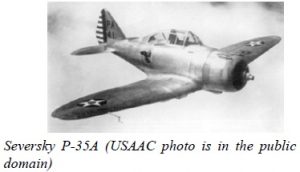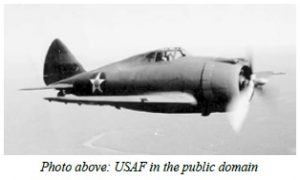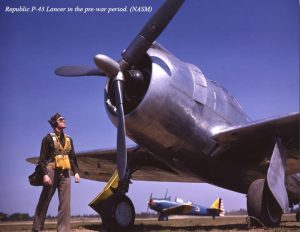by Martin Maisel (photos as credited)
In 1935 the USAAC announced a competition for a single seat fighter. Seversky, believing a two-place aircraft with a rear gunner would be more desirable, planned on submitting the SEV-2XP (2 seat, Experimental, Pursuit) to the competitive flight evaluation trials at Wright Field, Ohio.
While the aircraft was being transported by road to Wright Field, Seversky learned that the Curtiss Model 75 and Northrop 3A competitors both had one seat and had retractable undercarriages. The SEV-2XP was then reported to be “badly damaged” in transit, and Seversky requested, and received, permission to take the aircraft back to Farmingdale, Long Island for repairs.
 During the “repairs”, the SEV-2XP was modified to a one-seater and a retractable undercarriage was installed. The aircraft was re-designated the SEV-1XP, indicating the single seat configuration. Some cynics believed that the “accident” was a ruse contrived by Seversky to enable him to make his entry more competitive.
During the “repairs”, the SEV-2XP was modified to a one-seater and a retractable undercarriage was installed. The aircraft was re-designated the SEV-1XP, indicating the single seat configuration. Some cynics believed that the “accident” was a ruse contrived by Seversky to enable him to make his entry more competitive.
While Seversky managed the business aspects of his company, it should be noted that the engineering genius behind successful Seversky aircraft was chief engineer Alexander Kartveli.
 Following fly-off evaluations, the SEV-1XP was declared the winner and in June 16, 1936 Seversky was awarded a contract for the delivery of 77 aircraft, now designated the P-35, thus becoming the first all-metal (except for control surfaces), cantilever wing, retractable landing gear, enclosed-cockpit fighter aircraft purchased by the Army.
Following fly-off evaluations, the SEV-1XP was declared the winner and in June 16, 1936 Seversky was awarded a contract for the delivery of 77 aircraft, now designated the P-35, thus becoming the first all-metal (except for control surfaces), cantilever wing, retractable landing gear, enclosed-cockpit fighter aircraft purchased by the Army.
 The first delivery of a P-35 occurred in July 1937 but the Seversky company was inexperienced with mass production and further deliveries were exceedingly slow. It was not until the following spring that the First Pursuit Group received their P-35s. Concerned about slow deliveries, the USAAC contracted with Curtiss-Wright for 210 P-36 aircraft. The P-36 is the predecessor to the famous Curtiss P-40 Warhawk.
The first delivery of a P-35 occurred in July 1937 but the Seversky company was inexperienced with mass production and further deliveries were exceedingly slow. It was not until the following spring that the First Pursuit Group received their P-35s. Concerned about slow deliveries, the USAAC contracted with Curtiss-Wright for 210 P-36 aircraft. The P-36 is the predecessor to the famous Curtiss P-40 Warhawk.
By mid 1938 the Seversky company was in bad financial condition. Alexander de Seversky pursued foreign sales of P-35 variants and 20 aircraft “found their way” to Japan, apparently without official U.S. authorization. That sale further upset Seversky’s relationship with the USAAC. Although 60 export versions of the P-35 were later delivered to Sweden, the company remained financially troubled.
In October 1939, while Seversky was on a sales tour in Europe, the Board of Directors reorganized the company, renaming it as the Republic Aviation Corporation, and removing Seversky from the company he created.
 Under new management, Republic continued to develop a series of improved fighter aircraft initially based on the P-35. Employing a recently developed turbo-supercharged P&W R-1830 engine, the P-43 Lancer, first delivered in September 1940, offered improved high speed and high altitude performance.
Under new management, Republic continued to develop a series of improved fighter aircraft initially based on the P-35. Employing a recently developed turbo-supercharged P&W R-1830 engine, the P-43 Lancer, first delivered in September 1940, offered improved high speed and high altitude performance.
With a maximum takeoff gross weight of 8460 lb, the Lancer would deliver a top speed of 356 mph at altitude.
It should be noted that nearly all of the Seversky/Kartveli aircraft designs had an elliptical wing. While this wing planform enhanced performance,
it increased tooling and manufacturing costs, perhaps contributing to Seversky’s financial problems.
The Lancer would prove to be obsolete shortly after it was introduced. Republic Aviation’s effort to develop a more effective fighter for the Army Air Corps is described in Part 3.

